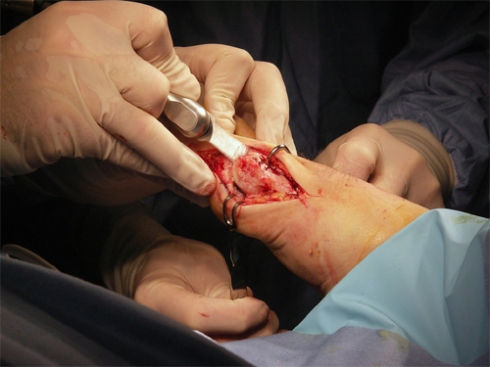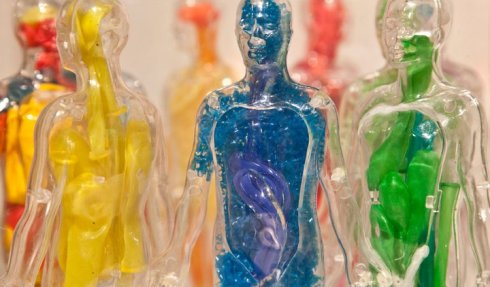
Saw, by David Edwards on Flickr
This is the text of a long abstract for a presentation given at the 15th biannual conference of the European Association of Museums for the History of Medical Sciences (EAMHMS), “Contemporary Medical Science and Technology as a Challenge for Museums” in Copenhagen on 16 September 2010. The original abstract included images; I have replaced them here with links to Flickr for convenience.
The explosion of digital photography in the last ten years has had an enormous impact on the practice of taking pictures. Digital cameras have made possible the production of a vastly increased number of personal photographs while the internet has provided practically unbounded means of access and distribution through photo-sharing websites like Flickr.
In 2010 Wellcome Collection set up a Flickr pool on the theme of ‘Medical London’ as an extension of our existing off/online Medical London project. In itself, this is no innovation: as Romeo and Waterson have noted, the Flickr pool is “a well-established museum outreach genre”[1]. It is no accident that Flickr is the photo-sharing website of choice for cultural heritage institutions. Where Facebook situates photography in a social aspect and Google’s Picasa excels in desktop integration, Flickr, and Flickr users, emphasise the aesthetic content of photographs themselves.
However, outreach is usually as far as museums’ Flickr projects go. Success is frequently measured by quantitative criteria (participation, entries) rather than any critical or curatorial measure. Although Galani and Moschovi contend that “contemporary amateur photographs as generated and published through social media applications have increasingly captured the curatorial imagination”[2] this has so far mostly been limited to curators and exhibitors working in the area of photography itself. Though the “internet stew” of photo-sharing websites like Flickr may be exactly where “the museum’s curatorial function is sorely lacking” according to Fred Ritchin[3], few non-photographic museums seem to have considered in detail what they might take, examine or curate from Flickr itself.
If photography has become pervasive, medicine always has been: a constant part of our lives both personally and socially. Photography might also have a therapeutic aspect: preserving the moment of life forever, where medicine ultimately fails. The Medical London pool, offering a theme both concrete and open, offers an opportunity to see where photography and medicine intersect. It is sufficiently local to attract what might be a community; there are enough potential subjects to avoid repetition. What follows is an attempt to use this pool to draw out some of the subjects, aesthetics and perspectives that might be of use to a medical museum in understanding and re-presenting everyday medicine. Six subject areas or possible approaches to the material are explored with examples.
In preparing this paper I’ve taken into account both the legal aspects of licensing on Flickr (only photos appropriately licensed or for which specific permission was given are included here: URLs for complete galleries are given alongside the pictures). I’ve also considered intentionality by only including images whose creators placed them in the pool, which suggests that they considered (however minimally) that the picture has a medical aspect, and can be understood by others in a medical context.
1. Objects
Through the Flickr pool we have access to images of objects which the museum does not possess. Pictures of hospital badges belonging to healthcare workers, medical instruments, charity boxes and large pieces of medical equipment have all been submitted to the pool. Where online we often consider a gallery of photographic images of objects to constitute meaningful access to our own collections, we might ask now whether it is possible to curate and present others’ images of objects.
Objects gallery
2. Location
Geospatial coordinates are an increasingly common property of photographs. Whether applied using Flickr’s map tools, or added by a GPS-aware mobile device, many pictures in the Medical London pool include information about where they were taken. On the map below, each pink dot represents one of the images in the strip, plotted onto the place where it was taken. If embedded in a form accessible to a mobile device, the potential exists to turn the city itself into a museum of its own medical history: from every location we can access nearby significant buildings, objects and events.
Interactive map
3. Documenting surgery
David Edwards documented his own bunion surgery in February 2007. As podiatric surgeons worked on his foot, a student podiatrist took pictures using Edwards’ camera. Here, the procedural becomes personal and while the foot remains the site of the operation, the subjectivity of the photography changes subtly: the pictures of the operation are authored by the patient.
Surgery gallery
4. Protest
Medicine has a social dimension, and even socialised healthcare in Europe is not simply a static service in which medics provide care to patients. A restructuring of services can spark protests by both healthcare workers and the local community. Here, the Flickr pool helps to provide a record of the dynamics of a changing health service in London.
Protest gallery
5. Other cures
Living in a multicultural city reminds us that ‘Western Medicine’ is no longer a primarily geographical category. The evidence of Chinese medicine, herbalism, homeopathy and other cures is everywhere in street photography, sometimes deliberately, sometimes accidentally. The ‘health food’ store is a sight as common as a pharmacy; while all cures might not be equal or even reputable, they all form a part of a medical landscape.
Other cures gallery
6. A new aesthetic: the empty hospital
The image of the hospital’s interior is familiar: wide corridors interrupted by fire doors; staff in uniform, patients in gowns and visitors in everyday dress; trolleys and other medical equipment. In the Flickr pool, through a combination of artists, healthcare workers, and ‘urban explorers’ investigating abandoned buildings, we unexpectedly discover a new aesthetic. The hospital, its spacious areas now bare, takes on an eerie feeling, like an empty diorama.
Empty hospitals gallery
Having seen its variety and considered its content, we might usefully ask in what ways the Medical London Flickr pool materially differs from a traditional photographic archive. Firstly, it is ongoing and open, offering a wide variety of subjects and modes, and few restrictions on submissions. Secondly, it is multiply authored, by both amateur and professional photographers. Thirdly, it can be collaboratively curated: galleries selected from it like the ones above can be made by anyone. Lastly, linked only by a strong but mutable idea, ‘Medical London’ photographs are open to constant reinterpretation by the photographers, the museum and others. As a nascent community it has yet to (and may never) develop any shared senses of photographic priorities. But the most important aspect of the pool is its capacity to offer us surprises: to see new subjects, aesthetics and understandings in what is offered to us.
If we wish to re-present these surprises to our audiences, how might we integrate the medical Flickr pool into the medical museum itself? In one way we already have, simply by connecting its online content to our existing presence: we are already used to museum exhibitions and projects having many limbs. If we wished to physically integrate these images into the museum, we might install a screen that dynamically highlights recent additions to the pool, as the Denver Art Museum does[4]. Or we might display the winners of a competition hosted by Flickr and integrate comments from Flickr into gallery interpretations, as the National Maritime Museum has[5].
Flickr has already proved to be highly effective at attracting audience engagement with the subject matter and collections of the museum. The curatorial question for museums now is how to engage with what audiences have produced. For a medical museum in particular, the challenge is how to find fresh perspectives from the mass of available material that we could loosely describe as ‘everyday medicine’. The ultimate result, however, will not be something that the museum has acquired, but rather something that it has fostered and shared.
Websites
www.flickr.com/groups/medicallondon
www.medicallondon.org
www.wellcomecollection.org
Acknowledgements
I would like to thank all the individually credited Flickr users for permission to use their photos in this paper, whether granted personally or through the use of Creative Commons licences.
References
[1]Romeo, F. and N. Waterson, ‘Flickr as Platform: Astronomy Photographer of the Year’. In J. Trant and D. Bearman (eds). Museums and the Web 2010: Proceedings. Toronto: Archives & Museum Informatics. Published March 31, 2010. Consulted July 12, 2010. http://www.archimuse.com/mw2010/papers/romeo/romeo.html
[2] Galani, Areti and Moschovi, Alexandra (2010) ‘Trans/forming Museum Narratives: The Accommodation of “Photography 2.0” in Contemporary Exhibitions’ in Transforming Culture in the Digital Age International Conference 2010: Proceedings. Consulted July 12, 2010. http://dspace.utlib.ee/dspace/handle/10062/14768
[3] Ritchin, Fred. After Photography. W. W. Norton & Co., 2008. p 115
[5] Romeo, F. and N. Waterson, 2010
Tags: contemporary biomedicine, Copenhagen, EAMHMS, empty hospitals, flickr, geolocation, hospitals, location, medical london, medical museums, medicine, museums, objects, protest, society, surgery, urban exploration, wellcome collection

